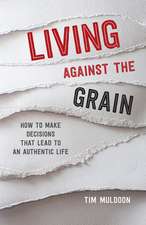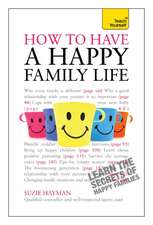Love As A Way of Life
Autor Gary Chapmanen Limba Engleză Paperback – 9 iul 2009
| Toate formatele și edițiile | Preț | Express |
|---|---|---|
| Paperback (2) | 57.29 lei 3-5 săpt. | +8.69 lei 4-10 zile |
| John Murray Press – 9 iul 2009 | 57.29 lei 3-5 săpt. | +8.69 lei 4-10 zile |
| Waterbrook Press – 30 iun 2009 | 108.69 lei 3-5 săpt. |
Preț: 57.29 lei
Nou
Puncte Express: 86
Preț estimativ în valută:
10.96€ • 11.45$ • 9.05£
10.96€ • 11.45$ • 9.05£
Carte disponibilă
Livrare economică 25 martie-08 aprilie
Livrare express 08-14 martie pentru 18.68 lei
Preluare comenzi: 021 569.72.76
Specificații
ISBN-13: 9780340964323
ISBN-10: 0340964324
Pagini: 256
Dimensiuni: 164 x 197 x 19 mm
Greutate: 0.21 kg
Editura: John Murray Press
Locul publicării:United Kingdom
ISBN-10: 0340964324
Pagini: 256
Dimensiuni: 164 x 197 x 19 mm
Greutate: 0.21 kg
Editura: John Murray Press
Locul publicării:United Kingdom
Notă biografică
Gary Chapman is a licensed marriage counsellor and popular conference speaker. The Five Love Languages has sold nearly four million copies around the world.
Extras
Introduction
My daughter, Shelley, and I boarded the plane in Phoenix feeling fortunate that we had been bumped to first class. I was assigned 4A, however, and she was seated in 7A, both window seats. All twenty-eight seats in first class were full, so we were hoping that someone would be willing to change seats so that we could be together for the four-hour flight.
Shelley said to the man seated in the aisle seat beside 7A, “Would you be willing to change seats so that I can sit with my father?”
“Is it an aisle seat?” the man asked.
“No, it’s a window seat.”
“Can’t do that,” he said. “Don’t like crawling over people to get out.”
“I can understand that,” Shelley responded as she took her seat.
A bit later the man who had been assigned the aisle seat beside me arrived. I said, “Would you be interested in sitting in Seven A so that my daughter and I could sit together?”
He glanced back at 7A and said, “I’d be happy to.”
“I really appreciate that,” I said.
“Not a problem,” he replied with a smile as he picked up his paper and moved to 7A.
Later I reflected on that incident. What accounted for the two different responses? The men were about the same age; late fifties or early sixties was my guess. Both were dressed in business attire. Yet one held to his aisle seat with tenacity, while the other freely gave up the aisle to accommodate our desire.
Could it be that one man had a daughter and the other did not? Could it be that the man who freely gave up the aisle seat really preferred a window seat? Or was it just that they had gone to different kindergartens and had different mothers? Had one been taught to share and help people, while the other to “look out for number one”? Did one have a loving gene that the other did not get?
For decades I have observed similar events, both large and small, and have asked myself, What makes the difference between “lovers” and those people who seldom show an attitude of concern and care for others? What are the characteristics of loving people? How were these character traits developed?
In the past year, trying to answer these questions, I have traveled the country observing behavior, interviewing people, reading available research, and examining religious teachings and practices. I have also drawn upon my thirty-five years of experience as a marriage and family counselor.
In the course of this study of love, I’ve named what I believe are the seven characteristics of a loving person:
• Kindness
• Patience
• Forgiveness
• Humility
• Courtesy
• Generosity
• Honesty
These seven traits are not vague feelings or good intentions. They are habits we learn to practice when we decide to become authentically loving people. They are basic, practical traits that are doable in everyday life. Yet the result of making these traits a habit is remarkable: satisfaction in relationships.
Love is multifaceted. It is like a diamond with many surfaces yet one display of beauty. In a similar way, when put together, the seven key characteristics of love form a loving person.
Each trait is critical. If you are missing one in your relationships, you are missing something significant.
I believe these traits are the keys not only to successful relationships but to success in all of life. That’s because the only way to find true satisfaction in life is to love others well.
How to Use This Book
In Love as a Way of Life you will find many stories from people across the country who have discovered, or are trying to discover, the joys of living out the seven traits of a loving person. You will also find practical ideas on how to develop these characteristics in your own life. Let me suggest that you not rush through the book but instead take the time to explore each facet of love in every type of relationship in your life. With that in mind, please note that each chapter in Part Two includes the following elements:
• Questionnaire. This simple self-test will challenge you to think through how one of the seven loving traits is shown in your life. I encourage you to take this test before you read the chapter in order to alert your mind to your strengths and weaknesses in relationships as you read about the character trait.
• A new definition. Early in each chapter I provide my definition of what a certain character trait looks like in the context of authentic love.
• Habits to acquire. Because each of the seven traits of a loving person is a habit, acting them out in daily life is built on smaller habits. The boxes throughout a chapter give you ideas about how to make the concept of loving authentically a reality in your life.
• Competitors. We wouldn’t need any book on love if we didn’t have emotions, personal weaknesses, and circumstances to overcome in our relationships. Each of the seven character traits has many competitors, or enemies, but usually one competitor stands out. In this section of each chapter, I’ll briefly look at one thing that might be working against developing a particular character trait in daily life. When we are alert to the competitors to love, we are better able to overcome them.
• “What would your relationship be like if . . .” I’ve found in my own life that it helps to dream about how things could be and then try to make those dreams real. This section, at the end of each chapter, encourages you to realize how different your relationships could be if you made some changes, even small ones, in how you relate to others.
• Making it personal. Whether you are reading this book alone or sharing the journey with a group, the questions at the end of each chapter will help you reflect on how the subject of the chapter relates to your life in specific ways. Since the goal of this book is that you not only will learn about love but will also become a better lover, at the end of this section I offer suggestions for personal growth.
Love as a Way of Life is for anyone who wants to have better relationships and succeed in life. Nothing has more potential for changing the world for good than loving actions that flow from people who value relationships. And as we’ll discover, nothing brings more joy than genuinely loving others.
I have written this book not in the technical language of psychology or sociology but in the language of the man and woman who live down the street. I believe it is the common person like you or me who holds the key to creating a world in which relationships are valued above all else, in which serving others is normal and expected, in which children grow up to respect each other–yes, even love each other. This is not an impossible dream. It is in fact a dream within reach of each of us.
From the Hardcover edition.
My daughter, Shelley, and I boarded the plane in Phoenix feeling fortunate that we had been bumped to first class. I was assigned 4A, however, and she was seated in 7A, both window seats. All twenty-eight seats in first class were full, so we were hoping that someone would be willing to change seats so that we could be together for the four-hour flight.
Shelley said to the man seated in the aisle seat beside 7A, “Would you be willing to change seats so that I can sit with my father?”
“Is it an aisle seat?” the man asked.
“No, it’s a window seat.”
“Can’t do that,” he said. “Don’t like crawling over people to get out.”
“I can understand that,” Shelley responded as she took her seat.
A bit later the man who had been assigned the aisle seat beside me arrived. I said, “Would you be interested in sitting in Seven A so that my daughter and I could sit together?”
He glanced back at 7A and said, “I’d be happy to.”
“I really appreciate that,” I said.
“Not a problem,” he replied with a smile as he picked up his paper and moved to 7A.
Later I reflected on that incident. What accounted for the two different responses? The men were about the same age; late fifties or early sixties was my guess. Both were dressed in business attire. Yet one held to his aisle seat with tenacity, while the other freely gave up the aisle to accommodate our desire.
Could it be that one man had a daughter and the other did not? Could it be that the man who freely gave up the aisle seat really preferred a window seat? Or was it just that they had gone to different kindergartens and had different mothers? Had one been taught to share and help people, while the other to “look out for number one”? Did one have a loving gene that the other did not get?
For decades I have observed similar events, both large and small, and have asked myself, What makes the difference between “lovers” and those people who seldom show an attitude of concern and care for others? What are the characteristics of loving people? How were these character traits developed?
In the past year, trying to answer these questions, I have traveled the country observing behavior, interviewing people, reading available research, and examining religious teachings and practices. I have also drawn upon my thirty-five years of experience as a marriage and family counselor.
In the course of this study of love, I’ve named what I believe are the seven characteristics of a loving person:
• Kindness
• Patience
• Forgiveness
• Humility
• Courtesy
• Generosity
• Honesty
These seven traits are not vague feelings or good intentions. They are habits we learn to practice when we decide to become authentically loving people. They are basic, practical traits that are doable in everyday life. Yet the result of making these traits a habit is remarkable: satisfaction in relationships.
Love is multifaceted. It is like a diamond with many surfaces yet one display of beauty. In a similar way, when put together, the seven key characteristics of love form a loving person.
Each trait is critical. If you are missing one in your relationships, you are missing something significant.
I believe these traits are the keys not only to successful relationships but to success in all of life. That’s because the only way to find true satisfaction in life is to love others well.
How to Use This Book
In Love as a Way of Life you will find many stories from people across the country who have discovered, or are trying to discover, the joys of living out the seven traits of a loving person. You will also find practical ideas on how to develop these characteristics in your own life. Let me suggest that you not rush through the book but instead take the time to explore each facet of love in every type of relationship in your life. With that in mind, please note that each chapter in Part Two includes the following elements:
• Questionnaire. This simple self-test will challenge you to think through how one of the seven loving traits is shown in your life. I encourage you to take this test before you read the chapter in order to alert your mind to your strengths and weaknesses in relationships as you read about the character trait.
• A new definition. Early in each chapter I provide my definition of what a certain character trait looks like in the context of authentic love.
• Habits to acquire. Because each of the seven traits of a loving person is a habit, acting them out in daily life is built on smaller habits. The boxes throughout a chapter give you ideas about how to make the concept of loving authentically a reality in your life.
• Competitors. We wouldn’t need any book on love if we didn’t have emotions, personal weaknesses, and circumstances to overcome in our relationships. Each of the seven character traits has many competitors, or enemies, but usually one competitor stands out. In this section of each chapter, I’ll briefly look at one thing that might be working against developing a particular character trait in daily life. When we are alert to the competitors to love, we are better able to overcome them.
• “What would your relationship be like if . . .” I’ve found in my own life that it helps to dream about how things could be and then try to make those dreams real. This section, at the end of each chapter, encourages you to realize how different your relationships could be if you made some changes, even small ones, in how you relate to others.
• Making it personal. Whether you are reading this book alone or sharing the journey with a group, the questions at the end of each chapter will help you reflect on how the subject of the chapter relates to your life in specific ways. Since the goal of this book is that you not only will learn about love but will also become a better lover, at the end of this section I offer suggestions for personal growth.
Love as a Way of Life is for anyone who wants to have better relationships and succeed in life. Nothing has more potential for changing the world for good than loving actions that flow from people who value relationships. And as we’ll discover, nothing brings more joy than genuinely loving others.
I have written this book not in the technical language of psychology or sociology but in the language of the man and woman who live down the street. I believe it is the common person like you or me who holds the key to creating a world in which relationships are valued above all else, in which serving others is normal and expected, in which children grow up to respect each other–yes, even love each other. This is not an impossible dream. It is in fact a dream within reach of each of us.
From the Hardcover edition.
Recenzii
Praise for LOVE AS A WAY OF LIFE
“Chapman follows up his five-million-copy bestseller The Five Love Languages with this wise, heartfelt guide to cultivating seven traits that lead to loving relationships. Whereas his work on love languages explored the primary ways people give and receive love, this book explores the nitty-gritty of an entire "attitude of love," with chapters on kindness, patience, forgiveness, courtesy, humility, generosity, and honesty. Each chapter includes quizzes, questions for reflection, and ideas for applying that chapter's teachings. All self-help books run the risk of cliché, but Chapman manages to make tried-and-true material feel fresh through carefully chosen examples from his pastoral counseling practice and his own life…. This book is head and shoulders above the bulk of self-help literature precisely because it is not about ‘self’ so much as helping others.”
- Publisher’s Weekly (starred review)
“Chapman follows up his five-million-copy bestseller The Five Love Languages with this wise, heartfelt guide to cultivating seven traits that lead to loving relationships. Whereas his work on love languages explored the primary ways people give and receive love, this book explores the nitty-gritty of an entire "attitude of love," with chapters on kindness, patience, forgiveness, courtesy, humility, generosity, and honesty. Each chapter includes quizzes, questions for reflection, and ideas for applying that chapter's teachings. All self-help books run the risk of cliché, but Chapman manages to make tried-and-true material feel fresh through carefully chosen examples from his pastoral counseling practice and his own life…. This book is head and shoulders above the bulk of self-help literature precisely because it is not about ‘self’ so much as helping others.”
- Publisher’s Weekly (starred review)














